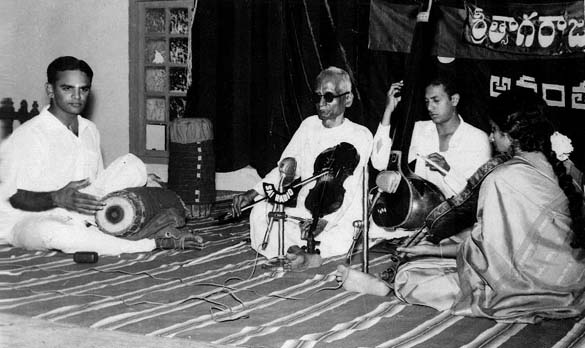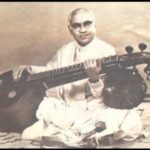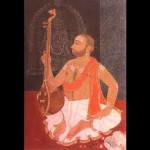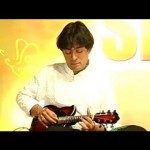In the long list of Eminent Telugu musicians is one who is both a traditionalist and an innovator. If culture is what unites a state and people, then here is one figure whose family and legacy cuts across caste and classicism, while upholding musical tradition.
Continuing our Series on Andhra Personalities is a fiddler who himself came to be known as ‘fidelu’: Dwaram Venkataswami Naidu.
Background
Dwaram Venkataswami Naidu was famously born in Bengaluru on Deepavali day, which was November 8, 1893. He spent most of his childhood in Visakhapatnam. He hailed from a family of Kasimkota cultivators (near Anakapalli), who later moved to Bengaluru. They became musicians, some of whom started off as army officers in the colonial regime. His father, Venkata Rayudu, was one such commissioned officer said to have played in a military band. They later left the army as the Independence Movement gained critical mass. Nevertheless, this was supplemented with training in the Carnatic tradition.
It is said that Venkataswami learned first from his father and then brother, Krishnayya Naidu who had supplemented his knowledge of the western tradition with tuition from a British station master. Krishnayya later received a greater grounding in Saastriya Sangeeta from Nandigana Venkanna Pantulu, who was Court musician at Bobbili. [4] With this rigorous musical background, he taught his younger brother Venkataswami the violin at the age of 6—paving the way for one of the musical legends of the era.
“Dwaram Venkataswamy Naidu was one of the most important Carnatic music violinists of the 20th century. ” [3]
There are, of course, numerous interesting anecdotes about his musical career. While Yehudi Menuhin seems to almost serve as an obligatory anecdote for modern musicians, Dwaram gaaru’s story seems to be among the more credible:
“Yehudi Menuhin, a world-renowned violinist, was greatly impressed when he heard Dwaram play at Justice P V Rajamannar’s house. Noted playback singer Ghantasala Venkateswara Rao learned Carnatic music under Naidu. Kalaimamani Radhanarayanan was also a disciple of Venkata Swamy Naidu.” [3]
“A musical legacy gives an artiste a brand name and an aura that goes a long way. The fortunate inheritors of music in our Telugu land are the Dwaram, Vasa and Nallanchakravartula families, whose names are synonymous with the Carnatic classical style in instrumental and vocal music.” [6]
- A preeminent Violinist despite partial blindness since childhood
- Appointed Professor of Violin in Vizianagaram Maharaja’s Music College at age 26
- Sangeetha Kalanidhi, Madras Music Academy (1941)
- Sangeet Natak Award
- Kalaa Prapoorna, Andhra University (1950)
- Padma Sri (1959)
While his physical impediment remained the most impressive aspect of his legendary musical career, Dwaram Venkataswami Naidu had a number of more acclaimed accomplishments to his name. His appointment to the Vizianagaram Music College as a professor at a young age would herald the contribution he would later make to Classical Indic Music in general.
“Venkataswamy was identified with the violin so much even as a boy of 14 that Marepalli Ramachandra Rao, an eminent critic, after being carried away listening to him, not only gifted a diamond ring but also christened him ‘Fiddle Naidu’—violin was also called fiddle, a derivative of fidula in German)—which became a household name in Andhra. ” [5]
He was a music laureate of the United Andhra Pradesh state government, and was later awarded the Padma Sri, by the National Government. [5]
Although violin solos were known under Govindaswami Pillai and Tirukodikaval Krishna Iyer, it was Venkataswami Naidu who popularised the violin’s presence in Carnatic Kutapas. Furthermore, he had a number of prominent students, such as Smt. Radhanarayanan as well as the great Ghantasala Venkateswara Rao.
Legacy
“Dwaram Naidu, popularly known as ‘fidelu’ Naidu was the first person to bring violin to the forefront of Carnatic music. He performed his first solo in Vellore in 1938. As he mastered the nuances of soft bowing with firm fingering, Naidu made the technique appear to be simple. ” [1]
His descendants, the brothers Dwaram Satyanarayana and Dwaram Durga Prasadarao, continue his legacy on carnatic violin to this day. [1] Other members of the Dwaram kutumbam include Dwaram Manga Tayaru, daughter of Dwaram Naidu, and her brother Dwaram Srinivasarao. [1] However, their wings have spread beyond violin.
“Dwaram Lakshmi is one of our top vocalists. The grand daughter of legendary violinist Dwaram Venkataswamy Naidu and daughter of great musician Dwaram Bhavanarayana Rao she took two Ph.Ds in music and trained under a host of noted vocalists such as M.L.Vasanthakumari, Mani Krishnaswamy and Nedunuri Krishnamurthy” [2]
The Ravana hatta is often cited as a precursor to the violin. Nevertheless, it’s quite clear that whatever its origins, the violin is a uniquely European instrument that was among the few imports into the conservative carnatic tradition. Indeed, some have in fact bemoaned it as having replaced the more traditional veena and tambura to the detriment of traditionalists. Regardless of where one stands in the debate, it is quite clear that the violin is a beautiful embodiment of musical equipment that can simultaneously move the mood and the soul. Dwaram Venkataswami Naidu gaaru was able to capture that in his raising of this instrument to prominence in our tradition.
It is almost difficult today to imagine a Carnatic Kutapa that would be complete without a violin. Whether or not that should be the case is another matter altogether. Nevertheless, as things stand today, it was a significant addition. A question worthy of consideration is whether marga traditions like Carnatic (better termed Dakshina Sangeeta) should limit themselves to native instrumentation and composition, while desi and jaanapaadha traditions be open to foreign influence. Rather than restrict musicians, who freely collaborate today for fusion purposes, it would be to free them from such concerns from purists. After all, sangeeta is not just about bhakti, but also historically had vinodam music for recreational purposes. It is the attempt to combine devotion with recreation that is the problem.
Regardless of one’s views, one thing is clear, Dwaram Venkataswami Naidu’s innovative inclusion of the violin into carnatic ensembles paved the way for the traditional sangeeta we know today. His life and legacy showed that Andhras were once not only musical and cultural doyens, but innovative ground-breakers in taking Classical Indic Culture and Music forward into the future.
“Endowed with a profound scholarship in the science of both Indian and Western styles, he made the violin a springboard of an arduous and ardent effort at evolving a synthesis of the well evolved techniques of bowing and fingering. His manodharma and even the choice of the composition, its placement and rendering reflected a picturesque entirety accomplished in a painting by Ravi Varma. ” [5]
References:
- ‘A fitting tribute to Dwaram Venkataswamy Naidu’. The Hindu. https://www.thehindu.com/entertainment/music/rich-repertoire/article25565416.ece
- ‘Seasoned artiste excels’. The Hindu. https://www.thehindu.com/features/friday-review/seasoned-artiste-excels/article6401543.ece
- ‘Dr. Dwarams birth Anniversary Celebrated Grandly’. The Hans India. https://www.thehansindia.com/posts/index/Andhra-Pradesh/2018-11-09/Dr-Dwarams-birth-anniversary-celebrated-grandly/439075
- ‘The Dwaram Legend’. https://www.thehansindia.com/posts/index/Hans/2015-11-04/The-Dwaram-Legend/184380
- ‘A titan among Violin wizards’. The Hindu. https://web.archive.org/web/20070128060107/http://www.hinduonnet.com/thehindu/mp/2002/08/26/stories/2002082600980200.htm
- ‘Footprints in the Sands of Time’. The Hindu. https://www.thehindu.com/features/friday-review/music/Footprints-in-the-sands-of-time/article14683077.ece







